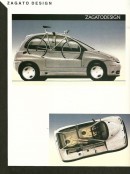Some of you may be asking yourselves why we feature such a heavy amount of bicycles on autoevolution. Well, before some of us were even born, around 1992, to be precise, companies were spitting out conceptual vehicles that blur the lines between different modes of transportation.
This seems to be the case with the 1992 Fiat Cinquecento Z-Eco, a concept car from one of Italy's most revered design studios, Zagato, a powerhouse team responsible for countless one-of-a-kind designs. Oh, and if you aren't aware of their work, you should get up to speed because this crew has been around since 1919 and doesn't seem to be going anywhere.
One design this gang spat out, one faithful 1992, is the Fiat 500 spinoff we'll discuss today. Why bring it to your screens? Quite a few reasons, one of which is that I've never seen a vehicle quite like this one. I mean, look at it, when's the last time you saw a car defined by the fact that it integrates a sort of bike rack into its design, form, and function?
Now, looking at the car, you can clearly see what it means to integrate this sort of function into the chassis of something like a '92 Fiat 500. But then again, it's no ordinary 500; this machine has been touched by the legendary Zagato design team. Considering this crew has been implicated in numerous projects centered on the bicycle, it was only a matter of time before they tried to blend two and four-wheelers.
So, what is going on here? Well, think of this concept as the sort of machine that helps you say goodbye to traffic jams by ensuring that your last-mile solution vehicle – your bicycle – is always by your side, literally.
To achieve this, we can see that there have been extensive modifications to the Fiat, including eliminating all but the wheels on the right side of the car. Actually, a better word than "eliminate" would be "repurposed" because that's what we have here. The front and rear passenger seats have been completely removed, and bodywork has been applied to ensure that the left side of the 500 is as car-like as possible.
The rest of the vehicle has only seen body modifications to make mounting a bicycle possible, and some of those changes include a different front bumper and redesigned rear. Funny enough, the modified rear also gives this ride a rather sporty look, yielded by that half-spoiler sitting behind the bicycle. Very Jekyll and Hide if you ask me. Note, however, that there is no mirror on the right side of the vehicle, so safety may have been one of the reasons why we don't see any of these on the streets nowadays.
Finally, I want to attract your attention to the cabin. One problem I see with this design is the distribution of weight. Because a driver, passenger, and bodywork have been shifted to the left side of the car, there could be some uneven tire wear, not to mention some rather scary turns. I do enjoy how Zagato treated this cabin as a fully functional one and included windows all around, including a modified rear windshield or glass. Imagine locking your keys in this car and having to break one of those custom windows.
Personally, I find this concept a rather fun one, not to mention functional. The only issues I see are the ones I mentioned above. I wonder what we would be given if Zagato took a crack at something like this during our modern era. Whatever the result, it would probably be as memorable as the one here.
One design this gang spat out, one faithful 1992, is the Fiat 500 spinoff we'll discuss today. Why bring it to your screens? Quite a few reasons, one of which is that I've never seen a vehicle quite like this one. I mean, look at it, when's the last time you saw a car defined by the fact that it integrates a sort of bike rack into its design, form, and function?
Now, looking at the car, you can clearly see what it means to integrate this sort of function into the chassis of something like a '92 Fiat 500. But then again, it's no ordinary 500; this machine has been touched by the legendary Zagato design team. Considering this crew has been implicated in numerous projects centered on the bicycle, it was only a matter of time before they tried to blend two and four-wheelers.
To achieve this, we can see that there have been extensive modifications to the Fiat, including eliminating all but the wheels on the right side of the car. Actually, a better word than "eliminate" would be "repurposed" because that's what we have here. The front and rear passenger seats have been completely removed, and bodywork has been applied to ensure that the left side of the 500 is as car-like as possible.
The rest of the vehicle has only seen body modifications to make mounting a bicycle possible, and some of those changes include a different front bumper and redesigned rear. Funny enough, the modified rear also gives this ride a rather sporty look, yielded by that half-spoiler sitting behind the bicycle. Very Jekyll and Hide if you ask me. Note, however, that there is no mirror on the right side of the vehicle, so safety may have been one of the reasons why we don't see any of these on the streets nowadays.
Personally, I find this concept a rather fun one, not to mention functional. The only issues I see are the ones I mentioned above. I wonder what we would be given if Zagato took a crack at something like this during our modern era. Whatever the result, it would probably be as memorable as the one here.








